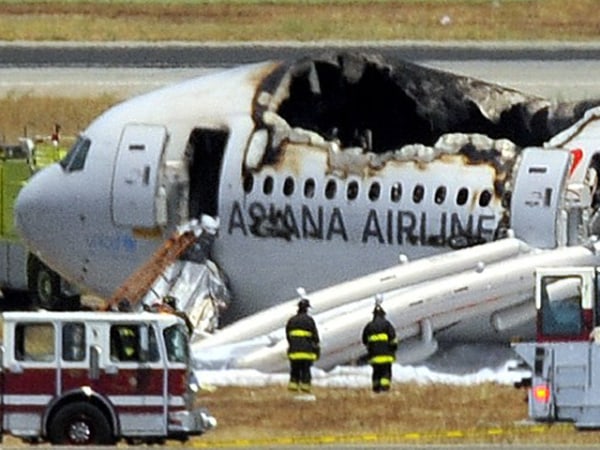Deborah Hersman, the chair of the National Transportation Safety Board, comments on the investigation into the cause of Asiana Flight 214's crash in San Francisco on Saturday.
By F. Brinley Bruton, Julie Yoo and Erin McClam, NBC News
The pilot of the plane that crash-landed on the runway in San Francisco was still training on the Boeing 777 and had never landed one at that airport, the airline said Monday.
Asiana Airlines said that the pilot, Lee Kang-kuk, had logged 43 hours flying the 777 over nine flights. It takes 60 hours and 10 flights to be considered fully qualified, the airline told NBC News. When a pilot learns a new type of aircraft, the status before full qualification is known as transition training.
?We know that there?s different levels of experience,? Deborah Hersman, head of the National Transportation Safety Board, told TODAY on Monday. ?We need to understand what was going on between these two crew members at the time.?
Lee had 9,700 hours of experience flying other jetliners ? the Airbus A320 and the Boeing 737 and 747, Asiana said. The co-pilot had more than 3,000 hours on the 777, a twin-engine, wide-body jet, the airline said.
Investigators continue to gather clues to explain why a Korean jetliner failed to land safely at San Francisco International Airport on Saturday, as recordings of cockpit conversations reveal the crew thought everything was fine until seconds before the crash. NBC's John Yang reports.
The plane, Asiana Flight 214 from Seoul, South Korea, clipped a seawall as it came in for a landing Saturday morning, then bounced along the runway before coming to rest in a field and catching fire, according to passengers and witnesses.
Two teenagers ? Chinese girls on their way to summer camp in the United States ? were killed. Authorities are investigating whether a fire truck ran over one of the girls as it raced to help.
It was the first fatal crash in the 18 years that the 777 has been in service. More than 180 people were injured.
Federal investigators said Sunday that the plane came in ?significantly below? its intended speed of about 150 mph and that the pilot and co-pilot tried to abort the landing a second and a half before it crashed.
Former NTSB investigator Greg Feith explains the key questions authorities will be attempting to uncover while determining what caused the plane's crash landing.
While it was Lee?s first time landing a 777 at San Francisco International, a South Korean transport ministry official, Choi Seung-youn, told Reuters that Lee had flown there 29 times on other aircraft.
Asked on TODAY whether the pilot?s inexperience landing the 777 at that airport might have been a factor, Hersman said investigators would consider it, but she added that it?s not unusual for pilots to make their first landing an at airport.
?They fly all around the world. There are a lot of different destinations,? she said. ?What you want to do is have a crew that?s proficient in the aircraft and works together well, that you have good crew pairings. That?s important.?
The news agency Yonhap quoted a South Korean official saying that ?transition training? status is common and within the government?s guidelines.
The training ?happens around the world every day of the week,? said Adrian Gjertsen, an aviation consultant and director of the British-based Airsupport Aviation Services Ltd.
?What happens in a good responsible airline is that while the guy is training in one seat the other guy will be a training captain,? or a pilot specifically trained to work with those in transition training, he added.
In a plane with engines the size of the 777?s, coming in too low is ?like setting off at the traffic lights in your car in fourth gear instead of first,? Gjertsen said. ?It takes you longer to accelerate if you move off in fourth.?
There was no evidence in the two so-called black boxes, the cockpit voice recorder and the flight data recorder, that the plane had problems before the crash, Hersman said Sunday at a news conference.
Passengers on Flight 214 recall the horrifying moments after an otherwise uneventful trip turned into a disaster. NBC's Miguel Almaguer reports.
She said investigators were also planning to interview with both pilots, the crew and passengers to reconstruct the landing. The president of the airline said Sunday that engine failure was probably not the cause.
The Associated Press reported Monday that before the Boeing 777 began filling with smoke, two evacuation slides on the doors inflated inside the cabin instead of outside, pinning two flight attendants to the floor.
Lee Yoon-hye, a cabin manager, said crew members deflated the slides with axes to rescue their colleagues.
?Right before touchdown, I felt like the plane was trying to take off. I was thinking, ?What?s happening??, and then I felt a bang,? said Lee, who has 20 years of experience with Asiana. ?That bang felt harder than a normal landing. It was a very big shock. Afterward, there was another shock, and the plane swayed to the right and to the left.?
She added: ?I wasn?t really thinking, but my body started carrying out the steps needed for an evacuation.?
Reuters and The Associated Press contributed to this report.
Related:

Josh Edelson / AFP - Getty Images
A Boeing 777 operated by Asiana Airlines crash landed at SFO.
This story was originally published on Mon Jul 8, 2013 5:31 AM EDT
world series giants Natina Reed Sandy Hurricane flight tracker Marina Krim Justin Bieber cancer
No comments:
Post a Comment
Note: Only a member of this blog may post a comment.